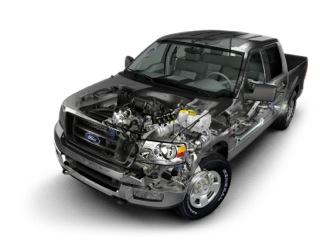Cam Lobe Design
In passing, it’s helpful to understand the basics of camshaft lobe design. To prevent excessive stress on the valvetrain, a cam lobe must be designed to gradually accelerate the mass of the lifter, push rod, rocker arm and valve. Overhead camshaft designs reduce valvetrain stress by replacing these components with a simple cam follower.
Unfortunately for mechanical camshafts, variations in valve lash will cause slight changes in valve timing. Since hydraulically adjusted camshafts don’t require a lash clearance, valve timing remains very consistent.
In either case, the cam lobe must be designed to gradually decelerate the valvetrain to prevent valves from bouncing off the valve seats at peak engine speeds. While camshaft lobes can be ground to increase air flow by increasing valve lift, the increased valve lift increases stress on the valvetrain as well as the potential for piston-to-valve interference.
See Photo 2.
Phasers Ready
Variable camshaft timing on early single-overhead camshaft (SOHC) engines was achieved by using a camshaft “phaser” consisting of a spring-loaded hydraulic piston forcing a beveled drive gear against a similar beveled drive gear mounted on the camshaft.
Precise camshaft timing can be achieved by using the Powertrain Control Module (PCM) to apply oil pressure to the piston by pulsing an oil control valve. Since the piston incorporates an orifice to bleed away oil pressure, cam timing can be changed by increasing the pulse width applied to the oil control valve.
If the electronics fail, a phaser return spring will push the piston to its default timing position. The PCM will also monitor camshaft position by comparing the relative positions of the camshaft position sensor (CMP) and the crankshaft position sensor (CKP). If those positions don’t correspond with the programmed data, the PCM should set a P0010-series or P0340-series trouble code.
Some VVT designs also incorporate a separate valve timing sensor (VTS) to provide a more precise valve timing feedback to the PCM. While most modern VVT designs use the more compact vane-type phasers to adjust valve timing, they continue to use the same basic arrangement of sensors and oil pressure control mechanisms to allow computer control.
See Photo 3.
VVT Failures
As you might have already guessed, VVT diagnostics is very application-specific because it not only depends upon whether the engine is an in-line or V-type block, or a SOHC or DOHC configuration, but also upon the configuration of the phaser and system electronics.
In addition, there are literally dozens of “global” P0010- and P0340-series trouble codes, not to mention manufacturer-specific P1000-series codes that can be stored due to a valve-timing problem.
But, by applying basic operating principles, it’s possible to diagnose most VVT failures, regardless of configuration.
It’s obvious that most VVT failures will result in a loss of low- or high-speed engine torque and affect intake manifold vacuum. When the camshaft is not responding to the positions commanded by the PCM, the PCM should store a camshaft-related timing P0340-series error code. On V-block engines, a camshaft timing error on one bank might also result in P0300-series misfire codes for all cylinders on that bank.
In addition, remember that valve timing and valve overlap affect cylinder compression. With a single-bank failure on a V-block engine, the bank-to-bank cranking compression should differ, as should the bank-to-bank fuel trim numbers.
Also, keep in mind that with the re-introduction of steel timing chains, a single loose chain or a worn tensioner or chain guide on one bank can retard cam timing and perhaps affect cold starting and driveability performance.
Engine oil viscosity as well as oil filter flow capacity can definitely affect the ability of the cam phaser to control valve timing, as can the service life ratings of the oil.
In many cases, a non-OE approved oil, coupled with a low-capacity oil filter, can cause sludging or varnishing, which causes cam phasers to stick in advanced or retarded positions.
This may also cause the oil passages in the cylinder head, oil control valve and phasers to clog with sludge or become contaminated with metal chips. Even when using OE or OE-approved oils, keep in mind that engine oil must be changed at recommended intervals.
Last but not least, many advanced diagnostic technicians routinely collect labscope samples of known-good CMP and CKP sensor waveforms for future comparison with those produced by a similar model afflicted with a suspected valve timing problem.
[inpost_gallery post_id=4977 group=”1″]














